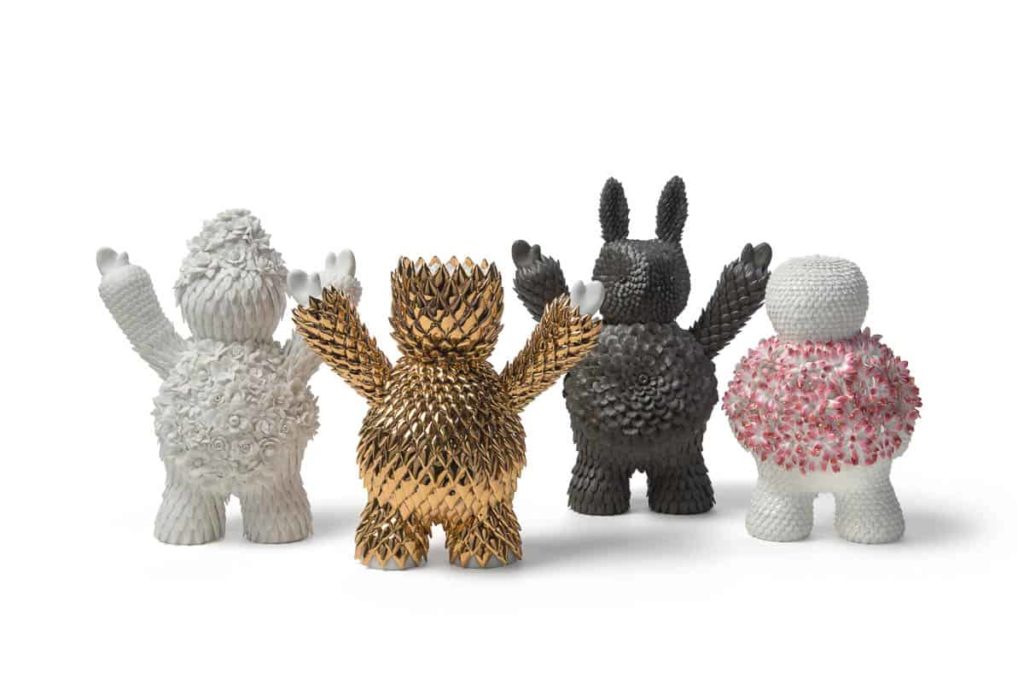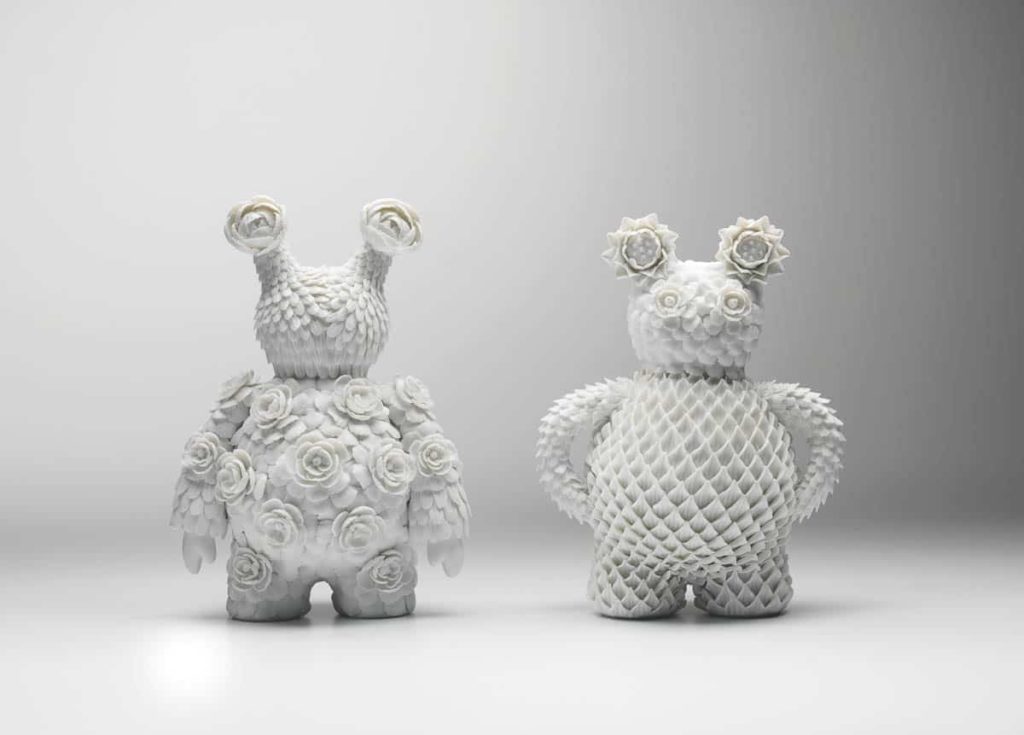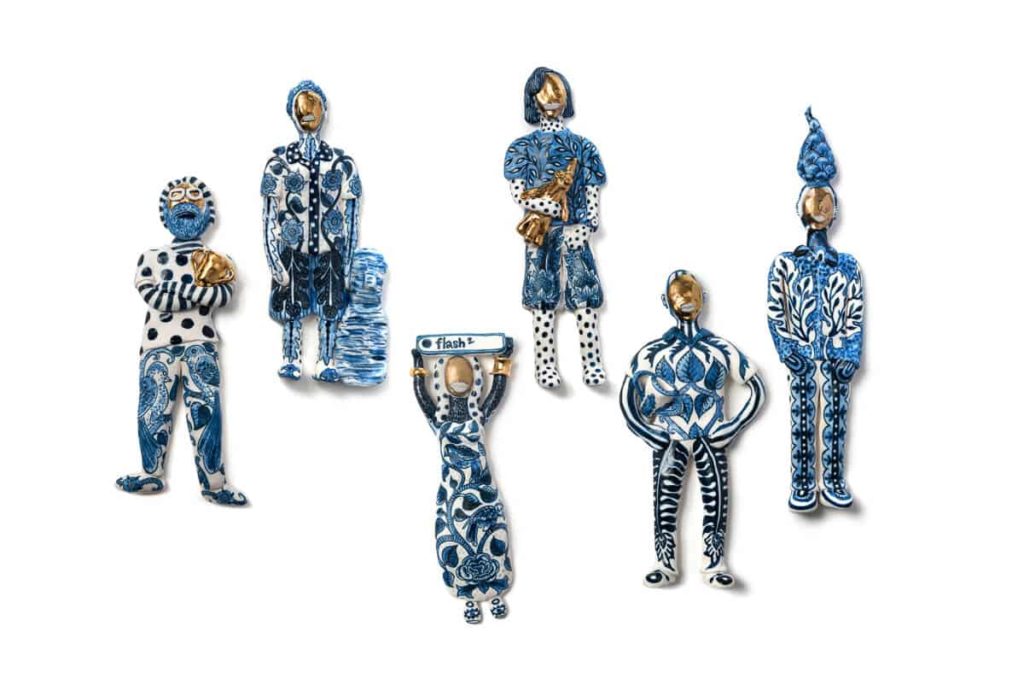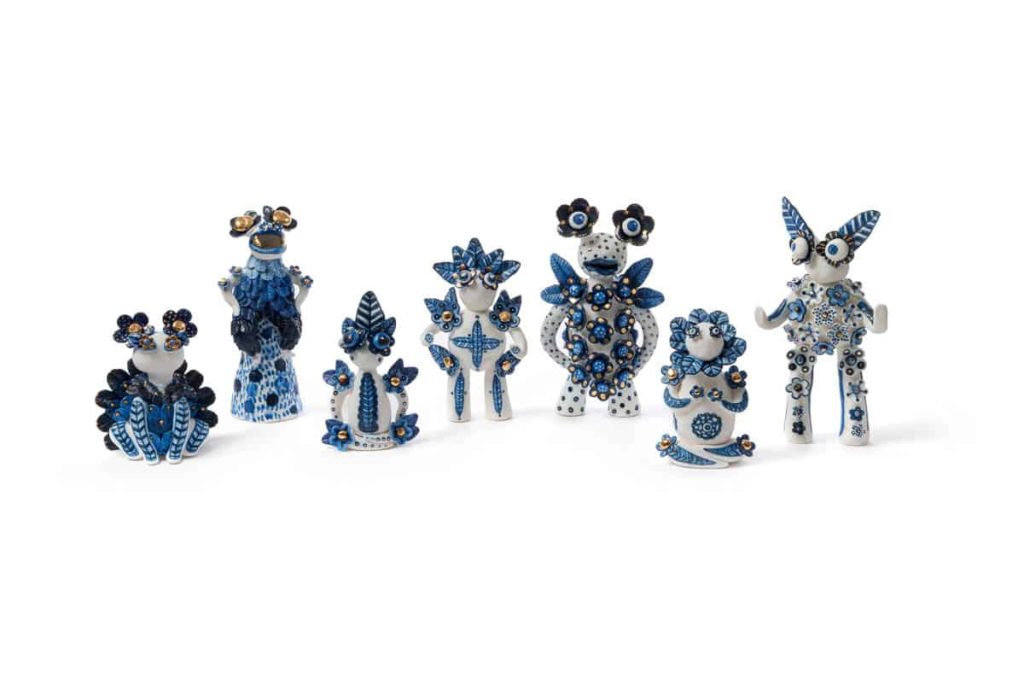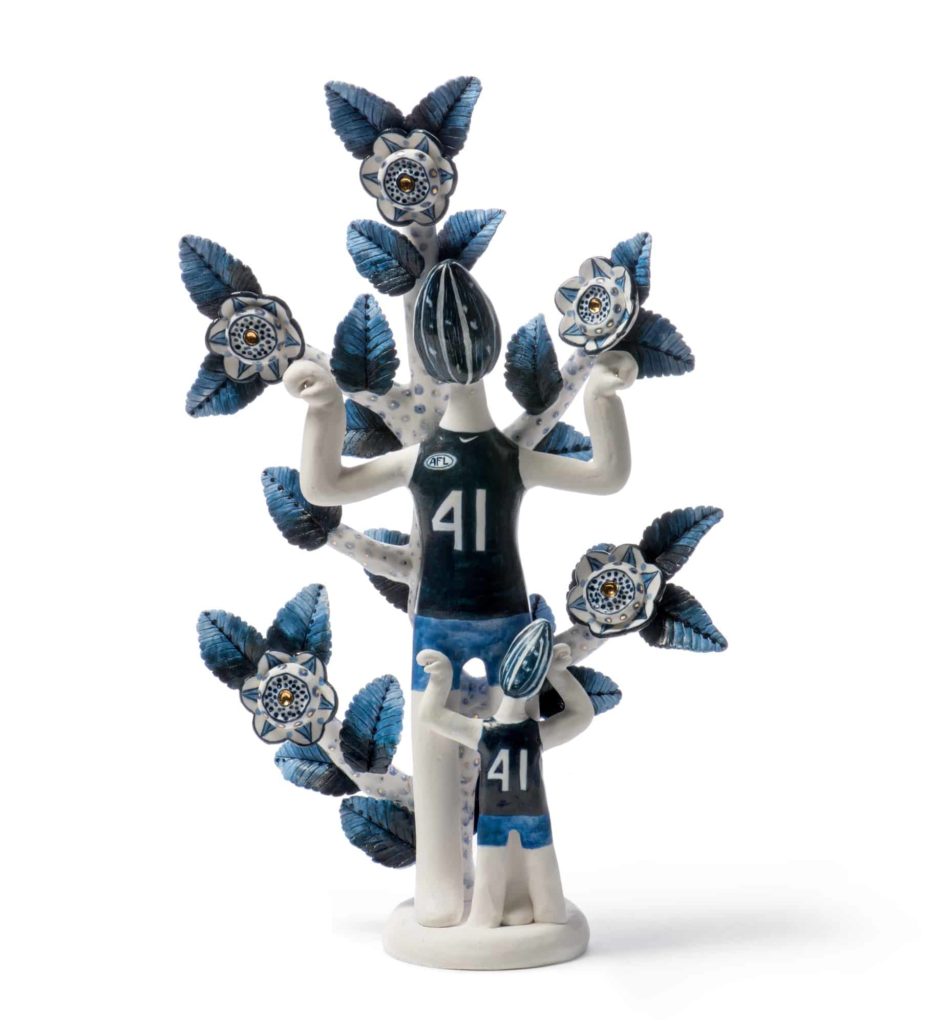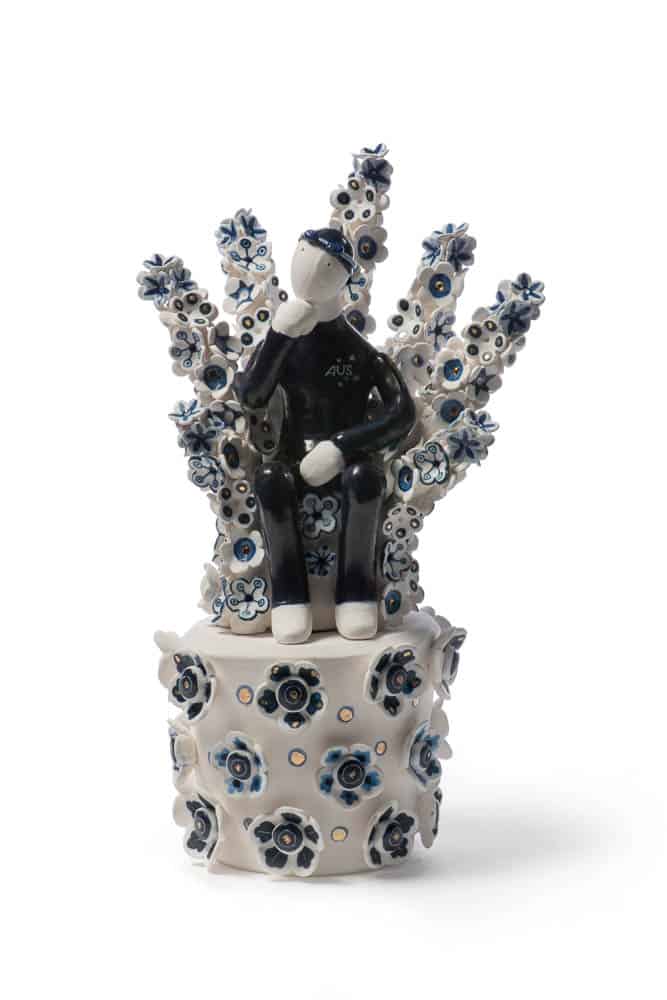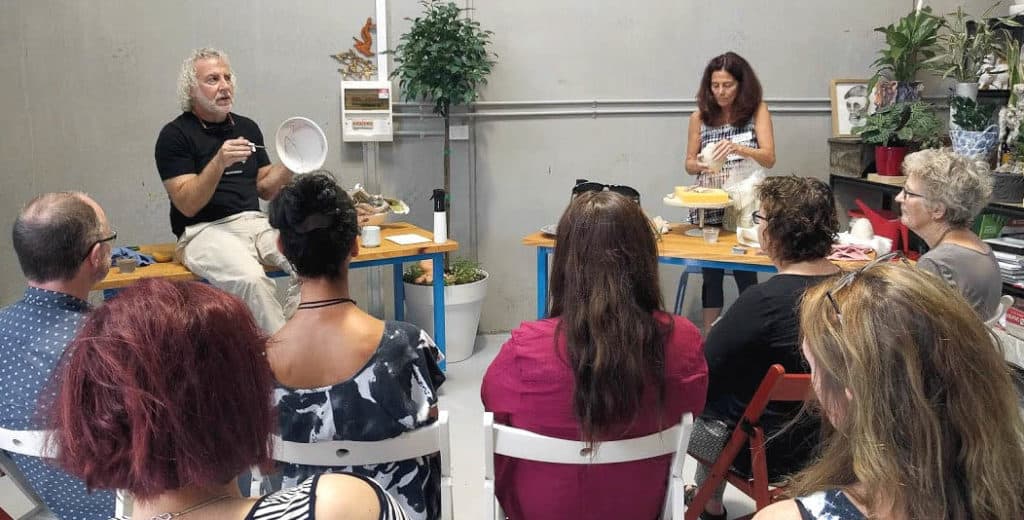- Vipoo Srivilasa, All Nation, Patience Flower Flower series, 2017
- Vipoo Srivilasa, 2014, photo: Grant Hancock
- Vipoo Srivilasa, Deity, 2016
- Vipoo Srivilasa, Hmi Buppha, 2016
Patience and beauty are the defining attributes of Vipoo Srivilasa’s philosophy and art, epitomised in one of his most thematically-”simple” ceramic sculpture series, Patience Flower 2010-present.
A set of teddy-bear-like creatures are covered by hundreds of hand-painted three-dimensional blossoms, each petal so delicate and unique that they seem like superior ossified versions of their natural world counterparts. Srivilasa says that he was inspired by an eighteenth century Meissen Snowball Blossoms Teapot he once saw in Germany: “I was most impressed by the amount of patience, concentration and skill that must have been required and it inspired me to create work with a similar resonance.” Although painstakingly-detailed, Srivilasa’s figurines do not seem overwrought with decoration—the eye is drawn to the shape as a whole before honing in on each tiny petal.
And what shapes! Srivilasa’s sculptures are impossibly adorable. Characteristically rotund and short-limbed and soft-featured, they are often surrounded by flowers or sitting astride other equally delightful creatures. Some of them might even look a little kitsch from afar– particularly when they are studded with fake rhinestones or pompoms, or gilded and bedecked with emblems of designer status (Louis Vuitton, Chanel, Yves St Laurent). Srivilasa is recognised internationally as one of the finest ceramic artists in terms of technical expertise and output. So what does it mean for the idea of “art” when an artist of his calibre has deliberately chosen to concentrate his talents in the service of creating “cute” objects?
The kanji for the Japanese word for cute, kawaii, literally means “able to be loved, loveable.” According to Shiokawa, In ancient times, kawaii carried a different meaning, one closer to the word “pitiable”. During the Shogunate period, under the ideology of neo-Confucianism, when the perception of women as animalistic was replaced with the conception of women as docile, women were classified as kawaii. From its very inception, kawaii has never been associated with power, only powerlessness, an expression of “compassion for children and the charm of being helpless.” To be cute, essentially, is to be perceived as innocuous, non-threatening, and therefore worthy of adoration. Or in contemporary times, think about it this way—if you are lucky enough to get a beautiful partner, beautiful car, beautiful house, you are also cursed. With such beauty often comes suffering—the Evil Eye, jealousy, resentment, insecurity. If you have a cute spouse, a small but charming cottage filled with mallard duck statues and floral wall-decals and drive a second-hand Fiat 500, you’re just lucky. Friends will still visit you, and not many will begrudge your happiness though they might question your taste. The notion of cuteness, unlike beauty, is not regarded as hard work but an easy blessing. Cute is often seen as unencumbered and unchallenging.
The commonly-held perception of cute is married to such an assumption of benign pleasantness that its power and force in society is rarely recognised. We all know “cute” when we see it, even if we cannot give voice to why certain faces, objects or animals stir in us such feelings of uncomplicated affection. In a 2006 article, the New York Times examined the appeal of cute from a scientific perspective, finding a wide-ranging set of features and behaviours as indicia of the trait: bright forward-facing eyes set low on a big round face, a pair of round ears, floppy limbs and a side-to-side, teeter-totter gait. Cuteness carries completely different attributes to beauty: clumsiness as opposed to precision, awkwardness instead of poise.
Dennis Dutton, the philosopher and author of The Art Instinct, wrote that “Cute cuts through all layers of meaning and says, ‘Let’s not worry about complexities, just love me.’” Dutton remarks that this is “where the sense of cheapness can come from… the feeling of being manipulated or taken for a sucker that leads many to reject cuteness as low or shallow.” The last major Western exhibition that dealt exclusively with the theme of cuteness was the 2013 exhibition “On Cuteness” at Halle Für Kunst Lüneburg in Germany. Yet even then, most of the exhibited pieces dealt with cuteness as a peripheral issue, or in oblique ways and there was not a furry baby animal or anime figurine anywhere to be found. “Straightforward”, warm-feelings cute, it seems, is often not regarded as serious enough for high art.
Srivilasa uses the concept of cute to explore more sinister themes of colonisation (Happyland II 2015), economic degradation (Red Eared Slider 2016), migration and belonging and settlement (Happyland 2014), and capitalistic greed and materialism (How to Make a Million Before Dinner 2013, Luang Phor Luang Pi 2012, Lai Krarm 2005). Certain pieces like Enlightenment (depicting a set of lotuses), and Joy Stick Twisted (consisting of a coil of petals extending towards the firmament) are evident in their Buddhist iconography, but in his most satirical collections, I found more nuanced reminders of my faith.
Seen in their elemental, unpainted state in his studio, the “animals” in Srivilasa’s work remind me of Kozydan’s screenprints parodying Hokusai’s The Great Wave woodblock print, with the foam of the wave made up of hundreds of tumbling bunnies, each one barely distinguishable from another, but all of them perfect. Through the small size of his sculptures and their indistinguishable faces, Srivilasa’s body of work playfully attacks the idea of the ego. Where his sculptures do have features, they usually only consist of two small dots for eyes. His sculptures are also fingerless and toeless, unable to fully grasp or attach to anything.
It is the objects surrounding Srivilasa’s “creature” that give it personality, identity, and a sense of place. In Luang Phor Luang Pi (Big Monk, Little Monk) the statuettes look like Mickey mice genetically engineered with Wedgewood flora, standing on pedestals. High Class Buddha is decked out in designer labels, looking more like a pimp than a god with its arms in gangsta mode and resplendent gold boater shoes on its feet. Similarly, in How to Make a Million before Dinner, the twelve figurines reference Apple, the TATE and MOMA, and other “famous” Western flagposts of culture.
“The twelve figurines represent a 12-step program to success I have constructed. Each step is personified by a famous work of art. Part of the fun of this work is in deciphering the tiny clues that I inscribe and leave on the figures. I hope that a curious viewer will linger and look closely for these markings.” (interview)
Reviewers and art critics (like Catecina Leone) have often noted the reverse-colonisation going on in Srivilasa’s work:
“Interestingly, both the 18th century porcelain designers and Vipoo, use the idea of the exotic other. One looked to the East and saw monkey orchestras, pagodas and parasols while the other, Vipoo, looks to the West and sees St Sebastian, the Statue of Liberty and the Birth of Venus.” (Ceramic Village)
I immediately recognise Rodin’s The Thinker covered in blossoms, Sidney Nolan’s Ned Kelly sitting astride a bunch of mollusc-like sea animals, in addition to the obvious ones like Venus and the Statue of Liberty; and I think I’ve done quite well. But then, immediately realising that most people who studied even just a small dose of Art History in high school would also be able to identify many of the figures, my smugness vanishes. I wonder why I would feel these feelings of superiority upon recognising some of the most common art pieces in the world, over and above those who might recognise some of the most common designer labels and corporate symbols also depicted on each sculpture?
When I see Srivilasa’s work, I am not so much reminded of the art of Takashi Murakami, but his philosophy on art. Murakami’s Superflat theory comments on post-war Japanese society as a place in which the difference between “high” art and “low” popular culture has “flattened out”. He once stated in an interview that “Japanese people accept that art and commerce will be blended; and in fact, they are surprised by the rigid and pretentious Western hierarchy of ‘high art.’” Srivilasa’s work makes us wonder, what are we without our status symbols? And has art become a modern-day status symbol too? Particularly for those of us who do not know too much about art, we are operating on vague notions that to be able to appreciate art shows a certain erudition and refinement. Often, the possession of art is used to reinforce our egos and status, even though we do not like to acknowledge these urges.
In fact, Srivilasa’s sculptures make me harbour sudden and unexpected dreams of acquisition. Exquisitely crafted in porcelain and painted in blue and gold, they bring to mind the Wedgwood China collections of a favourite grandmother or great-aunt, with a modern slant. Looking at the “rabbits” in his studio, removed from the hallowed gallery setting, sitting on shelves or peeking from inside kilns, they look tantalisingly accessible, almost like products of a “toy” production line. They are the sort of pieces that you wouldn’t be worried about having on your mantelpiece when intergenerational relatives come to visit. Unlike Murakami’s confronting anime children with their massive phalluses and breasts, Srivilasa’s work is quite tender and innocent. Of course, it is seditious, but in a secret nod-and-wink way, insulated by layers of charm.
- Vipoo Srivilasa, Deity, 2016
- Vipoo Srivilasa, Deity series, 2016
- Vipoo Srivilasa
- Vipoo Srivilasa, Deity, 2016
- Vipoo Srivilasa, Hare – Deity of Abundance 2016
- Vipoo Srivilasa, Peace – Deity of Victory, 2016
Srivilasa’s animals are not insecure or bashful about their cuteness, either. In Deity 2016 each sculpture has its own bespoke antique shrine (The shrines were made in collaboration with the artist’s friend Subhashok Angsuvarnsiri). They stand straight-backed, gazing at the viewer through small haughty eyes. Surrounded by offerings of flowers, blooming trees, supported by thrones and lotus-like stands (the sort found supporting the Chinese Goddess of Mercy), they invite worship. One gets the sense that it would be a tragedy to divide and isolate each figurine, that only by displaying them together does the theme become amplified. We are the Deities of Material Desire. We are the marauding rabbits.
Happyland has been described by Carol Schwarzman as depicting “animals … so cute you don’t know how bad they are – rabbits, feral cats – invaders”, thus setting up double-edged analogies with asylum seekers, the European appropriation of the Australian continent and his continuing investigation of the fluidity of borders between East and West. Seeing Srivilasa’s ceramic creatures reminded me of John Marsden and Shaun Tan’s allegorical book The Rabbits, the most innocuous creatures depicted as a sinister colonising force. Similar themes emerge in Red -Eared Slider and Indigo Kingdom. In this culture of “feels”, it seems perverse to kill or cull cute things. Some carnivores won’t eat cute animals like baby cows or lambs or rabbits, even though they would give not a second thought to chomping down on unsustainable, over-fished, over-farmed crustaceans. In discussing his exhibition “For the Future”, Srivilasa self-deprecatingly writes about his concern for the natural ecology of Australia and Thailand and “the damage that is being done to them as a result of society’s greed”:
“I hope the viewer can find humor in the works, despite the seriousness of the subject matter. The form of this current series is inspired by ceramic figurines of plump Chinese court ladies I saw in the Ming Tombs of Beijing. These figures reminded me of myself and other people around me, the way we continue to over-indulge and over-consume.”
In Animal, exhibited alongside Trooy Emery and Ramesh Nithiyendran, Srivilasa’s sculptures highlight how we project our own tame and unnatural aesthetics onto unsuspecting wild animals. His white figurines are covered in tiny petals, eyes rimmed with pink rhinestones, decorated all over with pink and white pompoms. They look like birthday cakes, or blown up versions of the sorts of baubles teenage girls have dangling from their iPhones or bag zippers—simultaneously blown massively out of proportion and yet rendered even more delicate by their painstaking porcelain detail. Indeed, animals have become mere objects for our consumption—literal or metaphorical. Kent Wilson in the exhibition writes that:
“We’ve really mistreated poor animals: “We domesticated it in a weird fetish for domesticating our own ‘animalistic’ tendencies. We’ve put bandages around their noses to breed in a flattened snout, identified faults in DNA to shrink carnivorous wolves into handbag Chihuahuas… and inflicted any number of horrors that culture and mass-industrialised capitalism has enabled.”
Yet anthropomorphism isn’t always to sinister ends. In Japan every prefecture has its own cute animal mascot; and in the Kumamoto prefecture, it is a black bear named Kumamon. The very first licensed Kumamon product was a Buddhist shrine emblazoned with the bear’s face, and when the 2016 earthquake hit, many people believed it was the hope and power of Kumamon that got them through the dark times. The government encouraged charities to use the mascot’s name and image for free in fundraising, and people rejoiced when Kumamon made his first public appearance a few weeks after the earthquake.
A group of Japanese researchers have even discovered that cuteness hones one’s fine motor skills by narrowing one’s attentional focus, useful behavioural modifications for handling infants or baby animals. Experiments hooking up volunteers to magnetic resonance imaging scanners have shown how images of cute creatures stimulates the brain to release dopamine. American journalist Nicholas Kristof points to the place of objects that may promote empathy and solace, and cites the example of teddy bears as sources of comfort for firefighters in the wake of 9/11. Cute things can have as much effect on a society as any other art form. Sometimes, they can have even more of an effect because to echo Dutton, cute transcends nuance and uncertainty, it “cuts through [the] layers.”
Hiroshi Nittono, director of the Cognitive Psychophysiology Laboratory at Osaka University, examined the effects of putting ‘cute’ markings on luxury goods and noted that “a high-quality product is somewhat distant from the customers—it looks expensive. But if you put kawaii nuance on such products, maybe such items can be more approachable.” Similarly, to ‘sell’ an idea – about environmentalism, materialism, Buddhism – Srivilasa disarms the viewer by assailing them with an avalanche of cute. Meanwhile, his sculptures remain cool, calm and collected. Standing to full attention in their glazed glory, this is pottery in full knowledge of its own potency.
✿
- Vipoo Srivilasa, 9 Fan Series, 2016
- Vipoo Srivilasa, Fan Series, 2016
- Vipoo Srivilasa, Fan Series, 2016
- Vipoo Srivilasa, Fan Series (detail), 2016
When we meet for the first time in 2016, Srivilasa has just moved into his new studio and the walls are austere and bare, though the space is very clean and tidy. It is a vision of concrete and new paint, zen-like in its possibility. Vipoo speaks to me with kindness and humility, assuming I know nothing about his work. He also jokes that many of the answers to questions interviewers usually ask him can be found by doing a quick google search. Luckily I had done my due diligence. Worried that I did not know enough about art or the art world to write a 5000-word essay about a world-renowned ceramics artist, for a year I went to every Srivilasa exhibition I could in Melbourne, including the Basil Sellers Art Prize.
This exhibition displayed Srivilasa’s trademark deities like sports trophies. One deity, decked out in designer clothing, holds a small golden ball in a languid pose that signals that the only sport it has ever done is yoga—there is no dynamism, no sharp edges to its physical form or movement. Another deity with a head like a tightly closed flower bud, in a footy guernsey, flexes his arms in the air. A very small facsimile of himself stands in front, the child version also in an identical muscle-man posture. The deity at the centre of the installation wears a skin-tight black wetsuit emblazoned with AUS on the left hand side of the chest—possibly where the heart is—and sits in a contemplative pose. The only deity that has small pinpoint eyes near the top of its head, this seems to be the most self-reflecting of the Sports Deities; a rebuff against the stereotype that sports-people and smart/artistic/philosophical people are mutually exclusive.
Srivilasa tells me that he wasn’t a footy fan but visited the house of a friend who was and was intrigued to see that they had set up a “shrine” of sorts in the lounge room. Curious to discover what drove enthusiasts to devote so much time to collecting objects, Srivilasa conducted clay modelling workshops with collectors of art and sports memorabilia to engage each group in conversation. The phrases on the work’s ceramic medallions were gathered during these conversations and include: I buy what I enjoy, to I’m not addicted and They collect dust all over the house, Art Shrine, Collecting is Modern Day hunting.
Srivilasa talks openly about his inspirations and motivations. He moved from Thailand to Tasmania in 1997, an island where the landscape is inescapable, even when one is in the city. He met his partner in Hobart, and they moved to Adelaide before settling in Melbourne from 2001. He says that he uses blue and white porcelain “as a reference to the export of ‘Blue and White’ porcelain from China to Europe. This is also a reference to my own personal migration from Thailand to Australia, from east to west.” He remarks that “nowadays, I find it is hard to tell which culture is which in my work, as both cultures merge nicely together in me. The boundary is a blur.”
“I am Thai in the way I am playful, happy and friendly. It’s interesting how one’s identity is often amplified in another culture. I was not looking to express my Thai identity explicitly, but it finds its way into my artwork.”
Outside of the ceramics world, Srivilasa is inspired by Nick Cave, an American visual artist (not the Australian brooding singer/director/writer) and one can see why— Cave’s Soundsuits become exploding cacophonies of colour when worn, and express the same pure unbridled joy as many of Srivilasa’s sculptures.
This is a portrait of the artist as a very happy man. Srivilasa discusses his medium with what can only be described as jubilation: “I … love the idea of turning a humble material into something fabulous and beautiful! I like working with my hands, and clay is the medium that best works well with hands. The excitement of opening the kiln is a big attraction, and after many years of working with clay, I still get excited every time I open the kiln.” He even once created an art-piece which depicts the text: “When I am in my studio, I feel like a virgin, touched for the very first time!”
Srivilasa’s other hobbies are gregarious ones—he enjoys cooking and going on social media, both of which are deeply connected to his art in significant ways. Srivilasa emphasizes the importance of “relational art” in his practice, where the artist is the mere “catalyst” for, rather than being at the centre of, the work. One example is an exclusive series of bespoke dinner parties that Srivilasa cooked and hosted, combining Thai food with his intricate ceramic artworks (Roop – Rote – Ruang: Taste – Touch – Tell, 2008). His guests were a mixture of artists, art professionals and members of the public. “The dinner introduces a different way of experiencing my work,” Vipoo explains, “the visitor not only looks at the artwork, but also tastes it, smells it, even hears it from the way the utensils touch the plates. They also learn about the very personal journey of how I came to Australia. Hence the dinner is always hosted in a private residence. It’s very intimate, and … people get to know each other really well.” As with the Fan 2016 exhibition, Roop Rote Ruang made a very specialised artisanal trade (pottery) engaging and relevant to the community.
Kevin Murray discusses the complexities relational art, particularly in the engagement of “third-world” artisans, which often has a political as well as aesthetic dimension. I am reminded of a story my parents told me about the Thai refugee camp where they stayed for a year before coming to Australia. In the camp, there was a traditional barter economy, where objects of value were traded. Refugees would make coke can rickshaws, toy cars and trucks and gift them to friends’ children as a gesture of friendship or trade them for other basic commodities. The more skilled the artisan, the more they could get for their craft. However, there was a particular craftsman who was so well-liked by the international aid volunteers, that they would bring his coke-can toys back to their home countries for their children. Of course at that time, no-one had seen anything like that before, and when my parents arrived, they were surprised to see Australians who supported refugees really treasuring these tin knick-knacks. I often think about that refugee along the Thai border, whose carved aluminium rickshaws first made it across the seas—he must have had a compelling personality to match his talent, for the recipients to call him a friend. When he was surviving the Killing Fields, my father made a guitar once out of scraps of wire and wood and tin for a Khmer Rouge leader, because the man with power of life and death over my father was an illiterate peasant who appreciated music. This small acts of social ingenuity and artistic skill saved my father’s life. Similarly, Srivilasa understands the role of art at this innate and fundamental level, at the level of genuine human connection. Yes, it is his livelihood, but the more people who can participate in its inspiration, creation and appreciation, the more meaningful it becomes.
Srivilasa has been exhibited widely throughout Australia and internationally in numerous high profile galleries including The Saatchi Gallery in London and is one of the most prolific ceramic artists in Australia. To get an idea of how accomplished he is, one only need to look at his CV—he has had at least one solo exhibition every year since 1997, and over seventy-five exhibitions worldwide since 2010. His friend the art writer Kevin Murray refers to him as an “unstoppable force.” He has been profiled and reviewed in almost every major ceramics publication both here and abroad. Srivilasa is indisputably a highly respected and collected artist, but the most fascinating thing I notice among Srivilasa’s reviews and interviews is that those who have had the pleasure of meeting him always, and without fail, write about how taken they were by his personality and warmth. I get the sense that Srivilasa’s character might be a rare thing in the art world.
In early 2016, Srivilasa started a Pozible campaign hoping to raise $13,800 to set up the basics of his current Clay Lab studio space: electricity and lighting, toilet and plumbing, sink and kitchenette, desks and chairs. His vision was to create “a place for cultural exchange for Melbourne’s ceramics community”, allowing him to offer community based projects “more often, more innovative and more experimental.” These include workshops by interstate and international artists, talks and conversations, mini-residencies and festival programmes, individual mentorships and a pop-up shop for people who live outside the city centre. His grander vision is to “create a network of like-minded creative studio owners around the world.” On 2 March 2016, a total of 112 supporters raised a total of $18 665.
In early February 2017, Vipoo invites me to attend his first Clay Lab workshop. His studio now looks finished, and it is very beautiful, filled with indoor and outdoor plants in hand-made, hand-painted pots of all sizes and shapes, paintings on the walls, and in the back-yard, an enormous bronze, soft-limbed Ganesh sculpture with an orange light-burst behind him. He sits atop a shrine of white bricks. In one of the small indoor trees at the base of the pot, an orange ceramic baby lies with its eyes closed, the epitome of peaceful sleep. The art in Srivilasa’s studio is in full view to anyone who wanders in—nothing hidden, no masterpiece possessively guarded in some secret enclave. Even the toilet is decorated with a complex, resplendent artwork depicting the relationship of two mermaids.
Twelve participants—mostly professional sculptures, art appreciators, and an early childhood educator—sit in Srivilasa’s first community workshop to watch and listen to a North Carolinian artist couple, Fred Johnston and Carol Gentither, as they create or paint their ceramic work and talk to us. While Johnston paints the inside of a bowl with two elegant sleek fish, Gentithes works on sculpting a monkey with Clay. Her inspiration is an Eric Carle illustration she shows us on her iPad, of a crouching monkey, his back and knees bent, his knuckles near the ground. Johnston speaks about how his representations of animals in art are inspired by the Brer Rabbit tales as well as Aesop’s fables, and his fascination with how they “showed the human condition through an animal.” He is also inspired by the South American Mimbres pottery with their striking black and white designs.
An excellent storyteller, Johnston segues from anecdotes about smuggling Alaskan walrus penile bones back to mainland United States via Canada, to commentary about the state of fine arts education funding in the US; from offering philosophical musings about the role of pottery through the ages, to personal tales about other famous ceramics artists. He mentions how some artists seem to be driven by ego, while others who are as equally intelligent and adept are generous and likeable and their careers are stronger for it. He is referring to a colleague in the States, but I think about Vipoo, who has laid out a feast for us during the break—cheeses and San Pellegrino and special lotus tea in his art mugs.
Gentithes spends two thirds of the workshop perfecting the torso of her monkey: making a basic pinch-pot body, stuffing the inside with plastic bags so that it held its shape, scoring it with a fork, smoothing it out with spatulas, scoring it some more, shaping the curve of the bent knees. It is actually quite calming to watch her at work, while listening to Johnston speak about Rainier Maria Rilke’s Letters to a Young Poet, and John Cage’s idea that a real artist learns all he can and then discards all he knows to create his art.
Because Gentithes is so quiet and consistent in her work, we don’t notice that she has completed most of the monkey until we see her attach the head. The near-completion of a complex ceramic sculpture in a little less than two hours awes me. When Gentithes finally turns the monkey around to face the audience, there is a collective “Awwwww!”, an exclamation of reflexive delight and surprise. First, because we had not realised that she had completed the face in such detail, with large blue taxidermy eyes like a teddy bear’s and two little pinpoint nostrils; and second, we are genuinely flabbergasted how cute it is. A few Clay Lab participants actually voice this sentiment and Gentithes laughs self-deprecatingly, trying to shrug off the compliment. Johnston also chuckles and explains that in art school they were taught that “only babies are meant to be cute. Art is not meant to be cute.” But there is no denying it—the giddy, mirthful feeling is immediate and palpable.
Art is meant to be serious, not decoration, it is meant to make you feel joy or revulsion or melancholy. It is not supposed to make you feel fuzzy inside. If it is endearing, that is either an incidental or accidental bonus, like the woolly-paintbrush effect of Auguste Renoir’s style. But back in his day, Renoir was not taken seriously. Critics said his paintings looked like he dragged wet wool across a canvas. Yet Proust said of him, “Before Renoir painted there were no Renoir women in Paris, now you see them everywhere.” Similarly, after visiting Srivilasa’s exhibits, I start to see how invidious the idea of “cute” is, how easily swayed I am by its permutations: whether down the toy aisle of K-mart with my toddler son, or noticing an immaculately-dressed woman down the business end of Collins street carrying a Pom Pom Purin handbag. Srivilasa’s work has made me more acutely aware of how easily smitten I am by advertising with “cute” themes, and how my perception of myself as a relatively unmaterialistic person constantly battles with my mindless urge to consume. In the end, like the creation of Srivilasa’s Patience Flower series, with discipline and persistence we hopefully learn to transcend all these urges. But to do this, we must be conscious of these urges in the first place.
Dutton suggests that “the rapidity and promiscuity of the cute response makes the impulse suspect, readily overridden by the angry sense that one is being exploited or deceived.” Yet the only reason art is often associated with beauty or pain or horror is that ultimately, it is meant to make you see the world in a different light. But Renoir did it purely by noticing light differently, without resorting to shock tactics. He looked at something ordinary, and painted it in an extraordinary way. Similarly, Srivilasa’s exquisitely beautiful work, his relational art and his community focus culminating in this first Clay Lab workshop, has the same effect on me.
As I sit in Vipoo’s studio watching Genthithes complete her ceramic monkey, I can see for myself that the energy in the room has clearly, palpably shifted. I see the mostly-female audience whisk out their phones, lean closer, take photographs, even get out of their seats for a better shot, and I understand that as much as we try and repress our basic preferences, often instinct overtakes us. So I beg to differ from Dutton’s view: cute is suspect only if you have pre-emptively decided that it can never be taken seriously as art.
Author
 Alice Pung lives at Janet Clarke Hall, the University of Melbourne, where she is the Artist-in-Residence. She is a Melbourne writer, essayist and teacher. Her books include Unpolished Gem and Laurinda.
Alice Pung lives at Janet Clarke Hall, the University of Melbourne, where she is the Artist-in-Residence. She is a Melbourne writer, essayist and teacher. Her books include Unpolished Gem and Laurinda.
Vipoo Srivilasa is represented by Edwina Corlette Gallery, Brisbane; Scott Livesey Galleries, Melbourne.
Bibliography
‘Kids’ happy popular bear mascot makes first public appearance since April earthquakes’, Japan Times, 6 May 2016.
‘Kumamoto’s Kumamon muscles quake fundraising’, Japan Times, 27 April 2016.
‘On Cuteness at Halle Fur Kunst Luneberg’, <http://www.contemporaryartdaily.com/2013/11/on-cuteness-at-halle-fur-kunst-luneburg/>.
‘Provocative and Colorful Artistic Dialogue by Takashi Murakami Opens in Valencia’, Art Daily News, viewed 16 February 2017, <http://artdaily.com/news/34471/Provocative-and-Colorful-Artistic-Dialogue-by-Takashi-Murakami-Opens-in-Valencia#.WJ2ss_l97IU>
Angier, N, ‘The Cuteness Factor’, New York Times, 3 January 2006.
Feagins, L, ‘Interview with Vipoo Srivilasa’, The Design Files, 5 July 2013, http://thedesignfiles.net/2013/07/interview-vipoo-srivilasa/
Leone, C, ‘Narratives in Blue and White’, The Journal of Australian Ceramics, November 2013, pp. 76-79.
Murray, K, ‘The party’s over, time to do the Dishes: Thinking about Relational Art and Craft’, Art & Australia Vol 47 No 2 Summer, 2009.
Nittono, H, Fukushima, M, Yano, A and Moriya, H, “The Power of Kawaii: Viewing Cute Images Promotes Careful Behavior and Narrows Attentional Focus”, PLOS ONE, vol. 7, Issue 9.
Schwartzman, C, ‘Vipoo Srivilasa: Equilibrium’, Brisbane Artguide, <http://bneart.com/whats-on/vipoo-srivilasa-equilibrium/>
Shiokawa, ‘Cute But Deadly: Women and Violence in Japanese Comics’, Themes and Issues in Asian Cartooning: Cute, Cheap, Mad and Sexy. Ed. John A. Lent. Bowling Green, Kentucky: Bowling Green State University Popular Press, 1999. 93–125.
Steinberg, N, ‘When Cuteness Comes of Age’, Mosaic, 19 July 2016
Teon, A, ‘Pretty Innocent Asian Girls: The Cult of Cuteness in East Asian Societies’, The Greater China Journal, 21 April 2016, accessed at < https://china-journal.org/2016/04/21/pretty-innocent-asian-girls-cult-of-cuteness-asia/>.
Werbler, A, ‘What’s in your toolbox: Vipoo Srivilasa’, Design Sponge, December 2015, http://www.designsponge.com/2015/12/whats-in-your-toolbox-vipoo-srivilasa.html
Wilson, K, ‘Animal’, Exhibition Notes, Nicholas Projects, 7-22 October 2016, https://nicholasprojects.org/animal/

